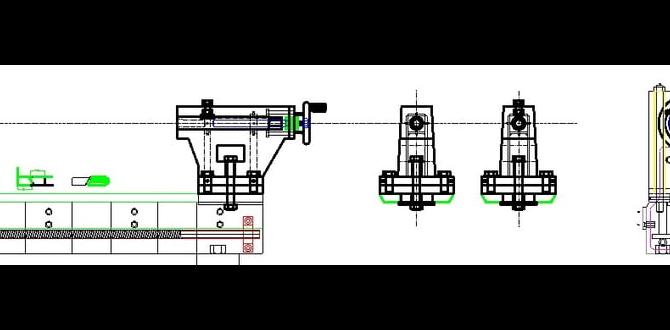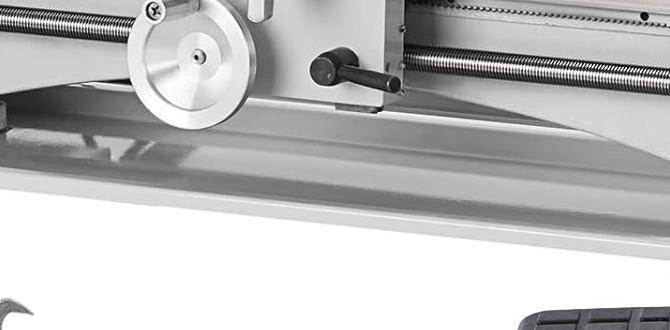Quick Summary
Mastering dry cutting of aluminum with a carbide end mill is straightforward. Use the right tool, proper speeds and feeds, and conservative depth of cut for clean, chip-free results. This guide breaks down the process for beginners, ensuring safety and success.
Working with aluminum on a milling machine can sometimes feel a bit tricky, especially for those just starting out. You might notice chips sticking to your workpiece, or perhaps the finish isn’t as smooth as you’d hoped. It’s a common hurdle many of us face when we’re learning the ropes of machining. But don’t worry! With the right technique, especially when dry cutting aluminum using a carbide end mill, you can achieve fantastic results. This guide will walk you through everything, step by step, so you can confidently tackle your aluminum projects. We’ll cover the best tools, how to set them up, and the crucial settings you need for success.
Carbide End Mills and Aluminum: A Perfect Match for Dry Cutting
When it comes to milling aluminum, especially without coolant, a carbide end mill is often your best friend. Why? Aluminum is a “gummy” material. This means it tends to stick to the cutting edge of tools, leading to poor chip evacuation and a rough finish. Carbide, being a much harder material than high-speed steel (HSS), can handle higher cutting speeds and temperatures, making it ideal for this application. Plus, specialized carbide formulations and geometries are designed specifically to shear and eject aluminum chips cleanly, even when dry.
For beginners, dry cutting offers a simpler setup. You don’t need to worry about managing coolant, which can be messy and add complexity. This makes it perfect for home workshops or educational settings where simplicity and safety are paramount. Let’s dive into what you need to know to get started.
Choosing the Right Carbide End Mill for Aluminum
Not all carbide end mills are created equal, especially when it comes to milling aluminum dry. Here’s what to look for:
Key Features of an Aluminum-Specific Carbide End Mill:
- Number of Flutes: For aluminum, 2 or 3 flutes are generally preferred for dry cutting. More flutes can sometimes lead to chip packing in gummy materials. The larger chip gullets of 2 or 3-flute cutters help clear chips more effectively.
- Coating: While not strictly necessary for basic dry cutting, coatings like ZrN (Zirconium Nitride) or TiAlN (Titanium Aluminum Nitride) can improve lubricity and tool life by reducing friction and heat. However, a plain uncoated carbide end mill can also work well if other parameters are correct.
- Sharpness and Geometry: End mills designed for aluminum often have highly polished flutes and a sharp cutting edge. They may also feature a slight positive rake angle to help shear the aluminum cleanly.
- Material and Size: Look for solid carbide end mills. Common sizes for hobbyist or general-purpose work include 1/8 inch and 1/4 inch diameters. For this guide, we’ll focus on a beginner-friendly setup using a standard length end mill, as it’s less prone to chatter.
Recommended Specs for Beginners:
For your first foray into dry cutting aluminum with a carbide end mill, consider these specifications:
- Diameter: 1/4 inch is a great starting point. It offers good rigidity and is versatile.
- Shank: A 1/4 inch shank is standard and will fit most common collets.
- Length: Standard length is generally preferred to minimize deflection and vibration.
- Flutes: 2 or 3 flutes.
- Material: Solid Carbide.
You can often find “aluminum-specific” end mills that feature these characteristics. They are designed to make your life easier when working with this material.
Common Aluminum Alloys You’ll Be Milling
Aluminum isn’t just one metal; it’s a family of alloys, each with slightly different properties. For hobbyists and makers, you’ll most commonly encounter:
- 6061 Aluminum: This is the workhorse of the aluminum world. It’s an alloy that offers a great balance of strength, weldability, and machinability. It’s relatively soft and can be prone to “galling” (sticking to the tool), making it a good candidate for learning proper cutting techniques. It’s widely available in sheets, bars, and extrusions.
- 5052 Aluminum: This alloy is known for its excellent corrosion resistance, particularly in marine environments, and good formability. It’s a bit harder than 6061 but still machines reasonably well.
- 2024 Aluminum: This alloy is known for its high strength but is more difficult to machine and less corrosion-resistant. It’s often used in aerospace applications. For beginners, it’s best to stick with 6061 or 5052.
For our purposes, we’ll assume you’re working with 6061, as it’s the most common and a great learning alloy. Understanding your material is your first step to successful machining.
Essential Setup: Tools and Machine Preparation
Before you even think about hitting the “start” button, a few things need to be in place. A solid setup is crucial for safe and accurate milling.
Tools and Accessories You’ll Need:
- Milling Machine: A CNC or manual mill capable of holding your workpiece securely.
- Collet Chuck/System: To hold your end mill precisely. A good quality collet set (e.g., ER collets) is essential for concentricity.
- Carbide End Mill: (As discussed above)
- Workholding: Vise, clamps, or fixtures to rigidly hold your aluminum workpiece. A sturdy vise is a must-have for beginners.
- Measuring Tools: Calipers, a dial indicator, or digital calipers for measuring offsets and dimensions.
- Safety Glasses: Non-negotiable. Always protect your eyes.
- Dust Collection (Recommended): While dry cutting aluminum, fine aluminum dust is produced. A dust collection system can help keep your workspace clean and reduce inhalation hazards.
- Deburring Tool: To clean up edges after milling.
Securing Your Workpiece: The Clamp Down
This is perhaps the most critical step. Your aluminum workpiece must be held absolutely rock-solid. Any movement during the cut will lead to poor finish, tool breakage, or worse, the workpiece coming loose.
- Vise: A good quality milling vise is the easiest way for beginners. Ensure the vise jaws are clean and the workpiece is seated firmly against the vise’s fixed jaw. Use soft jaws if you’re concerned about marring the surface.
- Clamping: If using clamps, ensure they are positioned to resist the cutting forces. You want to clamp down, not push the part away.
- Location: Position your workpiece so it’s well-supported and close to the features you’re milling. Minimize overhang.
Mounting the End Mill
Accurate tool holding is key to a good finish and tool life.
- Cleanliness: Ensure the collet, collet nut, and the end mill shank are perfectly clean and free of chips or oil.
- Insert: Insert the end mill into the collet nut, then thread the nut into the collet chuck.
- Tighten: Tighten the collet nut securely, ensuring the end mill is seated firmly. Use the appropriate wrench for your collet system.
- Check Runout: Ideally, use a dial indicator to check the runout of the end mill in the spindle. Less than 0.001″ (0.025mm) is desirable for good results. In many hobby setups, this is very close to zero if everything is clean and the collet is good.
Speeds and Feeds: The Heart of Dry Cutting Aluminum
Getting speeds and feeds right is where the magic happens. This is often the most intimidating part for beginners, but let’s break it down.
Understanding the Terms:
- Spindle Speed (RPM): How fast the tool rotates, measured in revolutions per minute.
- Feed Rate (IPM or mm/min): How fast the tool moves through the material, measured in inches per minute or millimeters per minute.
- Surface Speed (SFM or m/min): The speed at which the cutting edge of the tool is moving through the material. This is a more fundamental parameter that dictates cutting performance.
- Chip Load: The thickness of the chip being removed by each tooth of the end mill. This is critical for preventing chip recutting and ensuring good chip evacuation.
Calculating or Finding Your Settings:
For aluminum, high surface speeds are generally good, but chip load is paramount to avoid issues. You can use online calculators, manufacturer recommendations, or start with some general guidelines.
General Guidelines for Carbide End Mills in Aluminum (Dry Cutting):
These are starting points and may need adjustment based on your specific machine, end mill, and aluminum alloy.
| End Mill Diameter | Surface Speed (SFM) | Spindle Speed (RPM) for 1/4″ (6.35mm) | Feed Rate per Tooth (IPM or mm/tooth) | Chip Load per Tooth (Approximate, for 2-flute) |
|---|---|---|---|---|
| 1/8″ (3.175mm) | 300-600 SFM | ~3000-6000 RPM | 0.001 – 0.002″ (0.025 – 0.05mm) | 0.0005 – 0.001″ (0.013 – 0.025mm) |
| 1/4″ (6.35mm) | 300-600 SFM | ~1500-3000 RPM | 0.002 – 0.004″ (0.05 – 0.1mm) | 0.001 – 0.002″ (0.025 – 0.05mm) |
Important Note: The “Feed Rate per Tooth” is the most crucial figure when dealing with gummy materials like aluminum. For a 2-flute end mill, your overall Feed Rate (IPM) would be roughly: Feed Rate (IPM) = Spindle Speed (RPM) x Number of Flutes x Chip Load per Tooth (inches/tooth).
Example Calculation:* Let’s use a 1/4″ 2-flute carbide end mill on 6061 aluminum.
- Desired Surface Speed: 400 SFM
- Machine Spindle: Max RPM is 10,000.
- End Mill Diameter: 0.25 inch.
- Calculate RPM: RPM = (SFM x 12) / Diameter (inches) = (400 x 12) / 0.25 = 19,200 RPM. Our machine can’t do this. So, we’ll cap it at our machine’s max RPM. Let’s assume our machine can do 3000 RPM at that setting.
- Calculate Feed Rate: Let’s aim for a chip load of 0.0015 inches per tooth.
- Feed Rate (IPM) = Spindle Speed (RPM) x Number of Flutes x Chip Load per Tooth
- Feed Rate (IPM) = 3000 RPM x 2 Flutes x 0.0015 IPM/tooth = 9 IPM.
So, you might start with roughly 3000 RPM and 9 IPM. You’d listen to the cut. If it sounds “chattery” or “rubby,” you might need to increase the feed rate or adjust RPM. If it’s producing very fine dust or chips are welding, the chip load might be too small, or the RPM too high.
Chip Load is King:
For aluminum, a chip load that’s too small often results in the tool rubbing against the workpiece instead of cutting, generating heat and leading to poor finish. You want a chip that’s thick enough to evacuate easily. For a 2-flute end mill in 1/4″ diameter, a chip load of 0.001″ to 0.002″ is a good starting point. Thicker chips are often better for aluminum, provided your machine can handle the feed rate and maintain rigidity.
Air Cutting and Testing:
Always “air cut” your program first. This means running the code with the spindle off, then with the spindle at speed but the Z-axis not engaging the material. Listen for unusual noises and watch for any binding or excessive vibration. This also helps you verify your tool paths and offsets.
Dry Cutting Techniques for Aluminum
Now that you have your setup and settings, let’s execute the cut.
Depth of Cut (DOC) and Stepover
These adjust the amount of material removed in each pass. For beginner dry cutting of aluminum, conservative settings are best.
- Depth of Cut (DOC): When dry cutting aluminum, especially with a solid end mill, keep the depth of cut relatively shallow. For a 1/4″ end mill, aim for about 0.050″ to 0.100″ (1.2mm to 2.5mm) per pass. You might be able to go deeper with more rigid machines or specialized cutters, but start conservatively.
- Radial Depth of Cut (Stepover): This is how much of the end mill’s diameter engages the material horizontally. For roughing, a stepover of 30-70% of the tool diameter is common. For finishing, you’ll want a smaller stepover, perhaps 10-20%, to get a good surface finish.
Toolpath Strategies for Aluminum:
How you move the tool matters.
- Conventional Milling: The cutter rotates against the direction of feed. This tends to push the chip up and away, which can be good for chip evacuation but can sometimes lift the part or cause chatter.
- Climb Milling (Helical Milling): The cutter rotates in the same direction as the feed. This generates a thinner chip at the start of the cut and a thicker one at the end. Climb milling usually results in a better finish and puts less stress on the tool, making it ideal for aluminum. Almost always use climb milling when possible in aluminum dry cutting.
Many CAM software packages default to climb milling. Ensure you’ve selected this strategy if you have the option.
Managing Heat and Chips
Even though it’s “dry” cutting, heat is still generated. The key is to keep chips from re-welding to the tool or workpiece.
- Chip Evacuation: This is why we emphasize 2-3 flutes and adequate chip load. Ensure your machine’s spindle and axes can maintain the programmed feed rate without bogging down.
- Air Blast: A blast of compressed air directed at the cutting zone can be invaluable. It helps to blow chips away from the cutting area, preventing them from sticking to the tool or workpiece and helping to cool the cutting edge slightly. This is a simple, effective way to improve dry cutting performance. You can find simple air blast nozzles that attach to your machine.
- Feathering the Feed: If you notice chips starting to build up, you can sometimes “feather” the feed rate – slightly dropping it to let the tool clear itself a bit better.
How to Detect Problems Mid-Cut:
Listen carefully to the cutting sound. A smooth, consistent hum is good.:
- Screeching or Squealing: Often indicates the tool is rubbing, chip load is too low, or you’re running too slow/fast.
- Chating/Hammering: This usually means there’s too much deflection, the workpiece is loose, or the depth of cut is too aggressive.
- Smoky or Gummy Chips: The tool is overheating, likely from rubbing (chip load too low, RPM too high) or poor chip evacuation.
If you hear any of these, stop the machine immediately. Don’t try to push through. Assess the situation, adjust your parameters, and try again.
Achieving a Superior Finish
Getting a good surface finish on aluminum when dry cutting is achievable with attention to detail.
Finishing Passes:
For parts requiring a high-quality finish, a dedicated finishing pass is often necessary






